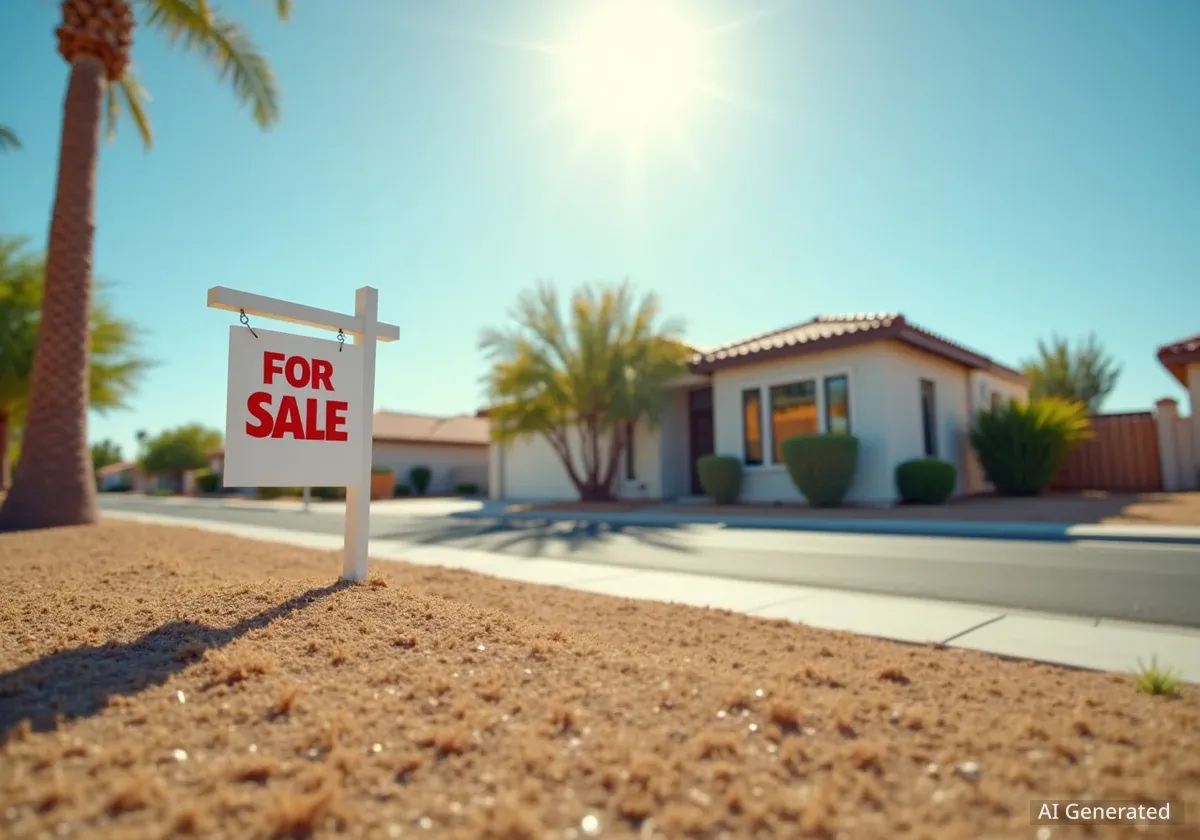The Las Vegas residential real estate market is experiencing a notable slowdown in sales activity, a trend directly linked to elevated mortgage rates. According to local industry experts, these higher borrowing costs are sidelining potential buyers and creating a more challenging environment for sellers, signaling a shift from the rapid pace seen in previous years.
Mike Roland, a veteran real estate agent and founder of The Roland Team brokerage, states that the market will likely remain sluggish until there is a significant reduction in interest rates. This cooling period affects not only transaction volumes but also related sectors, including new home construction and employment in the building trades.
Key Takeaways
- Elevated mortgage rates are the primary factor causing a slowdown in Las Vegas home sales.
- Real estate professionals anticipate the market will remain slow until borrowing costs decrease.
- The slowdown is impacting related industries, including new home construction and employment.
- Despite a cooler market, housing affordability remains a significant challenge for many Southern Nevada residents.
High Interest Rates Reshape the Housing Landscape
The primary force driving the current shift in the Las Vegas real estate market is the high cost of borrowing. As mortgage rates have risen, the monthly payments for prospective homebuyers have increased substantially, pushing many out of the market entirely. This has led to a noticeable drop in demand and, consequently, a decline in the number of closed sales.
Mike Roland, who has navigated various market cycles, emphasized the direct correlation between interest rates and market activity. He explained that until rates become more favorable, many potential buyers will remain on the sidelines, waiting for a more affordable entry point. This creates a challenging situation where sellers may need to adjust their price expectations to attract the smaller pool of qualified buyers.
Understanding Mortgage Rate Impact
A change in mortgage rates directly affects a buyer's purchasing power. For example, a 1% increase in the interest rate on a 30-year fixed mortgage can increase the monthly payment by over 10%. This significant jump can be the deciding factor for whether a family can afford to purchase a home, especially in a market where prices remain historically high.
The current environment contrasts sharply with the market of recent years, which was characterized by bidding wars and rapid price appreciation. Now, homes are staying on the market longer, and negotiations between buyers and sellers are becoming more common. This shift benefits buyers who can secure financing but presents a hurdle for sellers accustomed to a faster-paced market.
A Veteran Agent's View on Market Forces
Mike Roland's journey into real estate offers a unique perspective on navigating challenging environments. Before founding The Roland Team, a successful brokerage in Henderson, his career path was unconventional. He worked as a bartender and bouncer, roles that honed his skills in communication and understanding people from all walks of life.
His entry into the real estate profession was sparked by a chance encounter with a Groupon offer for real estate classes. This unexpected opportunity changed his professional trajectory, leading him to build a career helping clients navigate the complexities of buying and selling homes in Southern Nevada. His background gives him a grounded perspective on the economic pressures facing everyday families in the region.
"Until mortgage rates come down, the industry will continue to see a slowdown in sales," Roland stated, summarizing the core challenge facing the market today. His analysis points to a period of adjustment for buyers, sellers, and real estate professionals alike.
Roland's experience underscores the cyclical nature of the real estate market. He advises clients to focus on long-term goals rather than trying to time the market perfectly, especially during periods of volatility. His brokerage focuses on providing clear, data-driven advice to help clients make informed decisions in a complex financial landscape.
Economic Ripples Across Southern Nevada
The slowdown in home sales is not an isolated event; its effects are visible across multiple sectors of the Southern Nevada economy. The new home construction industry, a significant driver of local economic growth, has been particularly affected. Recent reports indicate that Las Vegas homebuilders have seen a sharp decline in sales as buyers grapple with affordability hurdles.
Construction Job Losses
According to the contractors' association in Nevada, the state has experienced a loss of thousands of construction jobs. This decline is largely attributed to the slowdown in homebuilding, though commercial construction is also beginning to show signs of cooling.
This reduction in construction activity has a cascading effect. It impacts employment for skilled tradespeople, reduces demand for building materials, and slows the development of new communities. The trend is a direct response to decreased buyer demand caused by higher interest rates.
Interestingly, while the for-sale market cools, the rental market is also experiencing a shift. A recent report highlighted that Las Vegas rents are dropping faster than in any other major U.S. city. This is fueled by a slowdown in migration to the area and a significant increase in the number of new multifamily units becoming available, which increases supply and puts downward pressure on rental prices.
The Enduring Challenge of Affordability
Despite the market slowdown, the fundamental issue of housing affordability remains a critical concern for Las Vegas residents. Even with a slower pace of sales, home prices have not decreased enough to offset the impact of higher mortgage rates. This creates a difficult situation where the dream of homeownership remains out of reach for a large portion of the population.
A study from the Lied Center for Real Estate at the University of Nevada, Las Vegas (UNLV) painted a stark picture of this reality. The research estimated that only 6.1% of all occupations in Southern Nevada pay a high enough wage to comfortably afford a median-priced home in the area. This statistic highlights a significant disconnect between local wages and housing costs.
This affordability crisis exists alongside a thriving luxury market. For instance:
- High-profile coaching hires at UNLV have recently purchased multimillion-dollar homes in exclusive guard-gated communities.
- New luxury neighborhoods, such as one in Summerlin with homes starting at $1.55 million, continue to see sales activity.
This dual market underscores the economic divide in the region. While high-income earners can still actively participate in the real estate market, many working families and individuals find themselves priced out. The current market slowdown, driven by interest rates, has done little to bridge this affordability gap for the average resident.





